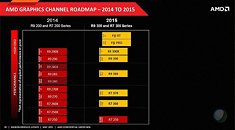- Joined
- Oct 9, 2007
- Messages
- 47,215 (7.55/day)
- Location
- Hyderabad, India
| System Name | RBMK-1000 |
|---|---|
| Processor | AMD Ryzen 7 5700G |
| Motherboard | ASUS ROG Strix B450-E Gaming |
| Cooling | DeepCool Gammax L240 V2 |
| Memory | 2x 8GB G.Skill Sniper X |
| Video Card(s) | Palit GeForce RTX 2080 SUPER GameRock |
| Storage | Western Digital Black NVMe 512GB |
| Display(s) | BenQ 1440p 60 Hz 27-inch |
| Case | Corsair Carbide 100R |
| Audio Device(s) | ASUS SupremeFX S1220A |
| Power Supply | Cooler Master MWE Gold 650W |
| Mouse | ASUS ROG Strix Impact |
| Keyboard | Gamdias Hermes E2 |
| Software | Windows 11 Pro |
It looks like AMD's desktop discrete GPU lineup for 2015 will see a mix of rebrands, re-codename, and one big new chip, all making up the new Radeon R7 300 and R9 300 series. Cards based in this lineup should begin rolling out this month. Leaks from OEMs such as this one, suggest that the first of these should begin rolling out as early as June 16.
The spread is pretty cut and dry. "Hawaii," the chip driving the R9 290 series, will not only get a new codename as "Grenada," but also a seamless rebrand to the R9 390 series, with Grenada Pro making up the R9 390, and Grenada XT making up the R9 390X. One possibility could be AMD taking advantage of low 4 Gbit GDDR5 chip prices to cram 8 GB of standard memory amount, across Grenada's 512-bit wide memory interface. The R9 390X will compete with the GeForce GTX 970, while the R9 390 will offer an option in the vast price and performance gorge between the GTX 960 and GTX 970.

The R9 280 series, has been a messy affair, with two chips, "Tahiti" (re-branded from the HD 7900 series, which dates back to 2012); and the newer "Tonga" silicon, which has similar specs to Tahiti, but a more modern Graphics CoreNext 1.2 stream processor implementation, which offers bare-metal support for Direct3D feature-level 12_0. This chip will get a fresh codename as "Antigua," and will drive a single SKU, the R9 380. The R9 380 could feature 4 GB of standard memory amount (either 4 GB using eight chips is cheaper than 3 GB using twelve chips, or 3 GB is a hard-sell). The R9 380 will compete with the GTX 960.
The "x70" moniker will get demoted from the Radeon R9 series, down to Radeon R7. There will be just one SKU, the Radeon R7 270, and it will be driven by the "Trinidad" silicon, which is a new code-name for "Curacao" (in turn "Pitcairn.") Again, one can expect similar specs to the older generation, but with standard memory amount doubled, to 4 GB. The "Tobago" silicon is a new code-name for "Bonaire," and will drive the R7 360. The "Oland" driven R7 250 will carry on unchanged.
"Fiji" is the only new chip here, and it's apparent that there will be not one, but two SKUs with a fancy SKU name. "Radeon Fury" is doing the rounds. The top-end part will ship with an AIO liquid cooling solution, while the second-best one could be air-cooled. We predict that Fiji XT could [attempt to] compete with NVIDIA's GM200-based SKUs, namely the GTX 980 Ti and the GTX TITAN X; while the Fiji Pro could give the GTX 980 a run for its money.
View at TechPowerUp Main Site
The spread is pretty cut and dry. "Hawaii," the chip driving the R9 290 series, will not only get a new codename as "Grenada," but also a seamless rebrand to the R9 390 series, with Grenada Pro making up the R9 390, and Grenada XT making up the R9 390X. One possibility could be AMD taking advantage of low 4 Gbit GDDR5 chip prices to cram 8 GB of standard memory amount, across Grenada's 512-bit wide memory interface. The R9 390X will compete with the GeForce GTX 970, while the R9 390 will offer an option in the vast price and performance gorge between the GTX 960 and GTX 970.

The R9 280 series, has been a messy affair, with two chips, "Tahiti" (re-branded from the HD 7900 series, which dates back to 2012); and the newer "Tonga" silicon, which has similar specs to Tahiti, but a more modern Graphics CoreNext 1.2 stream processor implementation, which offers bare-metal support for Direct3D feature-level 12_0. This chip will get a fresh codename as "Antigua," and will drive a single SKU, the R9 380. The R9 380 could feature 4 GB of standard memory amount (either 4 GB using eight chips is cheaper than 3 GB using twelve chips, or 3 GB is a hard-sell). The R9 380 will compete with the GTX 960.
The "x70" moniker will get demoted from the Radeon R9 series, down to Radeon R7. There will be just one SKU, the Radeon R7 270, and it will be driven by the "Trinidad" silicon, which is a new code-name for "Curacao" (in turn "Pitcairn.") Again, one can expect similar specs to the older generation, but with standard memory amount doubled, to 4 GB. The "Tobago" silicon is a new code-name for "Bonaire," and will drive the R7 360. The "Oland" driven R7 250 will carry on unchanged.
"Fiji" is the only new chip here, and it's apparent that there will be not one, but two SKUs with a fancy SKU name. "Radeon Fury" is doing the rounds. The top-end part will ship with an AIO liquid cooling solution, while the second-best one could be air-cooled. We predict that Fiji XT could [attempt to] compete with NVIDIA's GM200-based SKUs, namely the GTX 980 Ti and the GTX TITAN X; while the Fiji Pro could give the GTX 980 a run for its money.
View at TechPowerUp Main Site





 .
.
